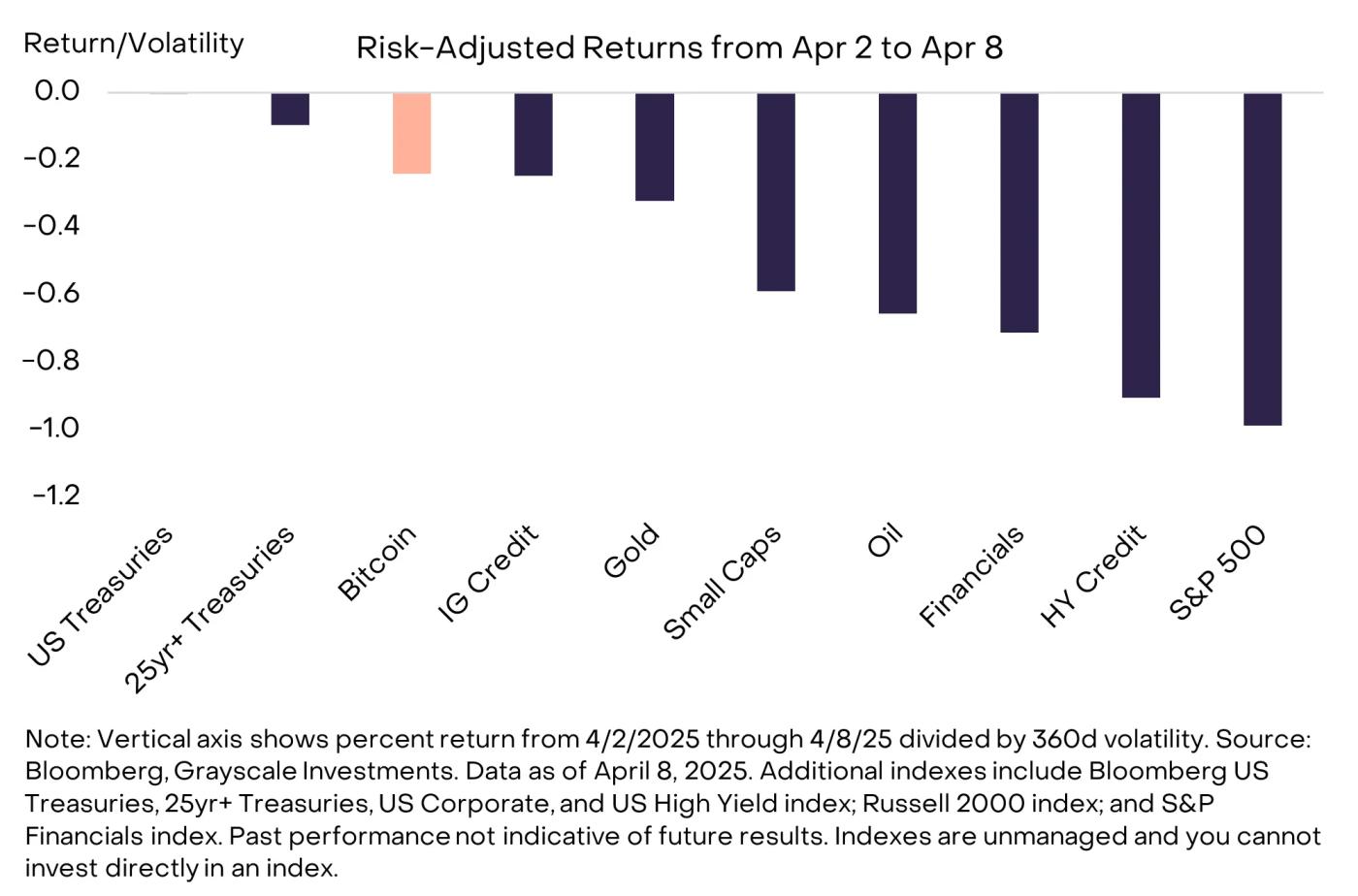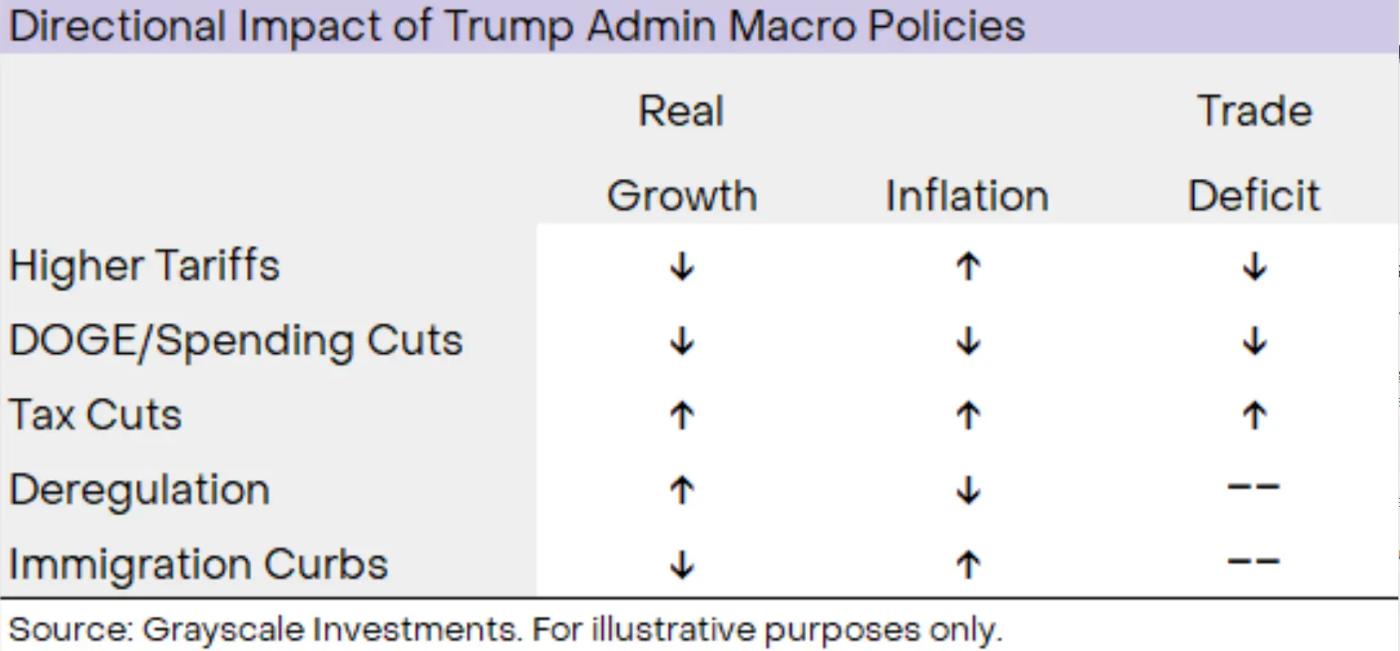Original Title: Market Byte: Tariffs, Stagflation, and Bitcoin
Original Author: Zach Pandl
Translated by: Asher, Odaily
Editor's Note: This article analyzes the impact of recent changes in U.S. global tariff policies on financial markets, particularly Bitcoin's unique performance; discusses the long-term effects of tariffs on the economy, asset allocation choices during stagflation, and the performance of Bitcoin and gold in such an environment; analyzes the impact of current trade tensions on the U.S. dollar and potential Bitcoin adoption, and finally provides an outlook on the economic prospects for the coming years, indicating that Bitcoin and other scarce commodities like gold may receive more attention and demand in a high-inflation environment.

Since the U.S. announced new global tariff policies on April 2, global asset prices have fallen sharply, only gradually recovering after Trump's announcement of suspended tariff policies (excluding China). However, the initial tariff announcement almost affected all assets, and during this period, Bitcoin's decline was relatively small in terms of risk-adjusted benchmarks. Therefore, if Bitcoin's correlation with stock market returns is 1:1, the S&P 500's decline should have meant a 36% drop in Bitcoin's price. However, the reality is that Bitcoin only dropped by 10%, highlighting that holding Bitcoin as part of an investment portfolio can still provide significant diversification benefits even during deep market retracements.

Bitcoin's price decline is relatively small after risk adjustment
In the short term, the global market outlook may depend on trade negotiations between the White House and other countries. While negotiations may lead to lower tariffs, setbacks in negotiations could also trigger more retaliatory actions, and the actual volatility and implied volatility of traditional markets remain high, making it difficult to predict how trade conflicts will evolve in the coming weeks. Therefore, investors should adjust their positions cautiously in a high-risk market environment. Moreover, the increase in Bitcoin's price volatility is far lower than that of stocks, and multiple indicators show that speculative traders' positions in the cryptocurrency market are relatively low. If macro risks ease in the coming weeks, the cryptocurrency market capitalization is expected to rebound.

Stock implied volatility is close to Bitcoin's
Regarding Bitcoin, although its price has declined over the past week, from a longer-term perspective, the impact of higher tariffs on Bitcoin will depend on their effect on the economy and international capital flows. Tariffs (and changes in related non-tariff trade barriers) may lead to "stagflation" and potentially cause structural weakness in U.S. dollar demand. Therefore, increased tariffs and changes in global trade patterns could be positive factors for Bitcoin adoption in the medium to long term.
Asset Allocation during Stagflation
[The translation continues in this manner, maintaining the original structure and translating all text while preserving the HTML tags and image sources.]Many central banks have intensified gold purchases after Russia faced Western sanctions. It is understood that currently, apart from Iran, no other country's central bank holds Bitcoin on its balance sheet. However, the Czech National Bank has begun exploring this option, the United States has established strategic Bitcoin reserves, and some sovereign wealth funds have publicly announced investments in Bitcoin. In our view, disruptions to the dollar-centered international trade and financial system may lead central banks to further diversify their reserves, including investing in Bitcoin.
The moment most similar to Trump's "Liberation Day" declaration in US history might be the "Nixon Shock" on August 15, 1971. That evening, President Nixon announced a comprehensive 10% tariff and ended the system of dollar convertibility to gold - a system that had supported global trade and financial systems since the end of World War II. This action triggered diplomatic activities between the US and other countries, ultimately reaching the Smithsonian Agreement in December 1971, where other countries agreed to appreciate their currencies relative to the dollar. The dollar ultimately depreciated by 27% between the second quarter of 1971 and the third quarter of 1978. In the past 50 years, there have been several trade tensions followed by dollar weakening (partially negotiated).

Recent trade tensions are expected to again lead to continued dollar weakness. According to relevant indicators, the US dollar is already overvalued, the Federal Reserve has room to lower interest rates, and the White House wants to reduce the US trade deficit. Although tariffs will change effective import and export prices, dollar depreciation may gradually rebalance trade flows through market mechanisms, achieving the expected effect.
Child of the Era - Bitcoin
The sudden changes in US trade policy are causing adjustments in financial markets, which will have short-term negative economic impacts. However, the market conditions of the past week are unlikely to be the norm for the next four years. The Trump administration is implementing a series of policy measures that will have different impacts on GDP growth, inflation, and trade deficits. For example, while tariffs may reduce economic growth and increase inflation (causing stagflation), certain types of deregulation might increase growth and reduce inflation (reducing stagflation), with the final result depending on the extent of the White House's policy agenda implementation in these areas.

US macroeconomic policies will have a range of impacts on growth and inflation
Despite the uncertain prospects, the best guess is that US government policies will lead to continued dollar weakness and overall inflation above the target within the next 1 to 3 years. Tariffs themselves may slow growth, but this impact could be partially offset by tax cuts, deregulation, and dollar depreciation. If the White House also actively pursues other growth-promoting policies, GDP growth may remain relatively good despite the initial tariff impact. Regardless of actual growth, historical evidence suggests that sustained inflationary pressures over a period may be favorable for scarce commodities like Bitcoin and gold.
Moreover, just like gold in the 1970s, Bitcoin now has a rapidly improving market structure - supported by changes in US government policies. This year, the White House has implemented a series of broad policy changes that should support investment in the digital asset industry, including withdrawing a series of lawsuits, ensuring asset applicability to traditional commercial banks, and allowing regulated institutions (such as custodians) to provide cryptocurrency services. This, in turn, has triggered a wave of mergers and acquisitions and other strategic investments. New tariffs are a short-term negative factor for Bitcoin's valuation, but the Trump administration's cryptocurrency-specific policies have consistently supported the industry. Overall, the increased demand for scarce commodity assets in the macroeconomic environment and the improved investor operating environment may be a powerful combination for widespread Bitcoin adoption in the coming years.







